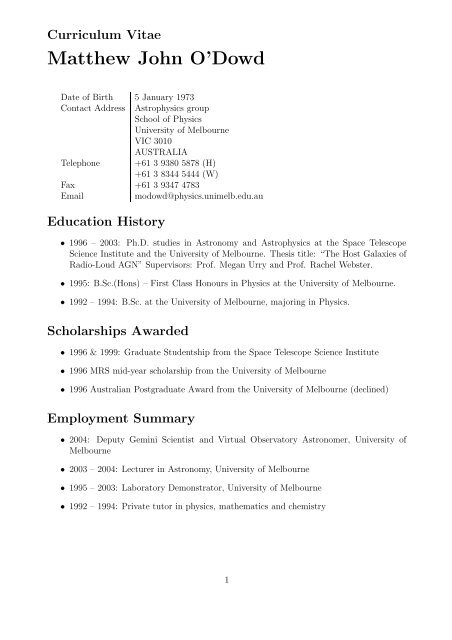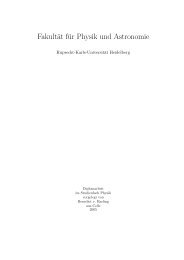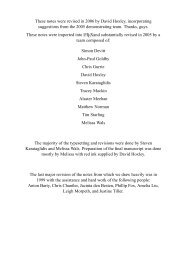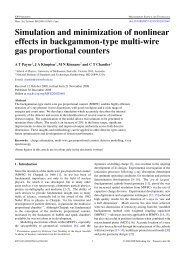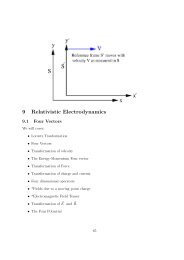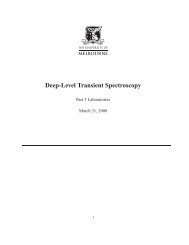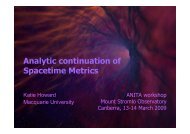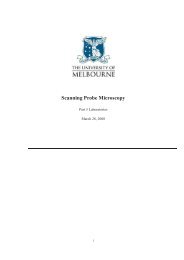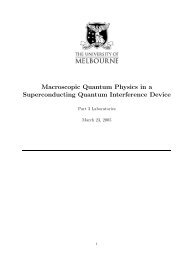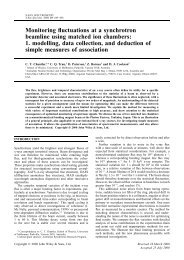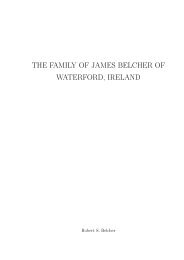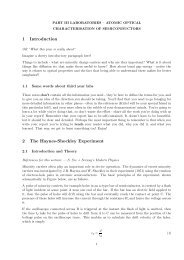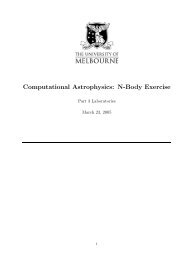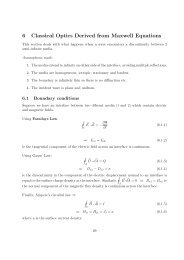Matthew John O'Dowd - School of Physics - University of Melbourne
Matthew John O'Dowd - School of Physics - University of Melbourne
Matthew John O'Dowd - School of Physics - University of Melbourne
You also want an ePaper? Increase the reach of your titles
YUMPU automatically turns print PDFs into web optimized ePapers that Google loves.
Curriculum Vitae<br />
<strong>Matthew</strong> <strong>John</strong> O’Dowd<br />
Date <strong>of</strong> Birth 5 January 1973<br />
Contact Address Astrophysics group<br />
<strong>School</strong> <strong>of</strong> <strong>Physics</strong><br />
<strong>University</strong> <strong>of</strong> <strong>Melbourne</strong><br />
VIC 3010<br />
AUSTRALIA<br />
Telephone +61 3 9380 5878 (H)<br />
+61 3 8344 5444 (W)<br />
Fax +61 3 9347 4783<br />
Email<br />
modowd@physics.unimelb.edu.au<br />
Education History<br />
• 1996 – 2003: Ph.D. studies in Astronomy and Astrophysics at the Space Telescope<br />
Science Institute and the <strong>University</strong> <strong>of</strong> <strong>Melbourne</strong>. Thesis title: “The Host Galaxies <strong>of</strong><br />
Radio-Loud AGN” Supervisors: Pr<strong>of</strong>. Megan Urry and Pr<strong>of</strong>. Rachel Webster.<br />
• 1995: B.Sc.(Hons) – First Class Honours in <strong>Physics</strong> at the <strong>University</strong> <strong>of</strong> <strong>Melbourne</strong>.<br />
• 1992 – 1994: B.Sc. at the <strong>University</strong> <strong>of</strong> <strong>Melbourne</strong>, majoring in <strong>Physics</strong>.<br />
Scholarships Awarded<br />
• 1996 & 1999: Graduate Studentship from the Space Telescope Science Institute<br />
• 1996 MRS mid-year scholarship from the <strong>University</strong> <strong>of</strong> <strong>Melbourne</strong><br />
• 1996 Australian Postgraduate Award from the <strong>University</strong> <strong>of</strong> <strong>Melbourne</strong> (declined)<br />
Employment Summary<br />
• 2004: Deputy Gemini Scientist and Virtual Observatory Astronomer, <strong>University</strong> <strong>of</strong><br />
<strong>Melbourne</strong><br />
• 2003 – 2004: Lecturer in Astronomy, <strong>University</strong> <strong>of</strong> <strong>Melbourne</strong><br />
• 1995 – 2003: Laboratory Demonstrator, <strong>University</strong> <strong>of</strong> <strong>Melbourne</strong><br />
• 1992 – 1994: Private tutor in physics, mathematics and chemistry<br />
1
Curriculum Vitae: <strong>Matthew</strong> O’Dowd<br />
Research Experience<br />
• Observing: Extensive experience observing with world-class telescope facilities, including<br />
CFHT, the 2.5m and 1m telescopes at LCO, the 4m Blanco telescope at CTIO, the<br />
4m Anglo-Australian Telescope. Familiarity with CCD imaging, long-slit and multiobject<br />
spectroscopy, and adaptive optics. Extensive experience in designing HST imaging<br />
programs.<br />
• Data reduction: Experience in reduction <strong>of</strong> optical and infrared imaging data and optical<br />
long-slit, multi-object and integral field unit spectroscopy. Broad experience with data<br />
from both ground-based telescopes and HST.<br />
• Data analysis: Broad experience in the development and application <strong>of</strong> new modelling,<br />
fitting and statistical analysis techniques.<br />
• Scientific writing: Several successful observing proposals (including three successful<br />
HST proposals, and refereed journal and conference proceedings papers (see attached<br />
publication record).<br />
Research Interests<br />
• Galaxies — evolution, dynamics, stellar population spectral synthesis<br />
• AGN — formation and fueling processes, host galaxies, the radio-loudness dichotomy<br />
• Black holes — the link between the AGN phenomenon and the evolution <strong>of</strong> black hole<br />
mass and spin<br />
• Cosmology — modelling the merger history <strong>of</strong> the universe and using AGN as probes<br />
<strong>of</strong> structure formation<br />
Computing Skills<br />
• Extensive experience in scientific programming with IDL and Fortran<br />
• Extensive experience with IRAF (including IRAF scripting and pipeline development)<br />
• Pr<strong>of</strong>icient with UNIX, Linux and Windows<br />
• Pr<strong>of</strong>icient with L A TEX and with Micros<strong>of</strong>t Office (Word, Excel, PowerPoint)<br />
• Very good typing skills.<br />
2
Curriculum Vitae: <strong>Matthew</strong> O’Dowd<br />
Science Presentations<br />
• Space Telescope Science Institute AGN Journal Club, 1997, Baltimore. Oral presentation:<br />
“Finding Host Galaxies with HST”<br />
• 191st AAS Meeting, 1997, Washington DC. Poster presentation: “Finding AGN Host<br />
Galaxies with HST, and the Joint Analysis with Ground Based Images”<br />
• Invited Speaker, Astronomical Society <strong>of</strong> Victoria Annual General Meeting, 1998, <strong>Melbourne</strong>,<br />
Australia. Oral presentation: “Active Galactic Nuclei”<br />
• Fourth Stromlo AGN Workshop, 1999, Canberra. Oral presentation: “The AGN Power–<br />
Host Galaxy Connection”<br />
• Life Cycles <strong>of</strong> Radio Galaxies, STScI Symposium, 1999, Baltimore. Poster presentation:<br />
“Host Galaxies and the Unification <strong>of</strong> Radio-Loud AGN”<br />
• QSO Hosts and Their Environments workshop, 2000, Granada. Oral presentation: “The<br />
Nucleus–Host Galaxy Connection in Radio-Loud AGN”<br />
• 25th meeting <strong>of</strong> the IAU, 2003, Sydney. Poster presentation: “1517+656: a BL Lac in<br />
its Birth Throes”<br />
• ASA Annual Scientific Meeting, 2004, Brisbane. Oral presentation: “Host Galaxy Evolution<br />
in Radio Loud AGN”<br />
Other Interests<br />
• Literature, creative writing, film, travel, rockclimbing, outdoor activities, martial arts<br />
Referees<br />
• Pr<strong>of</strong>. Rachel Webster<br />
<strong>School</strong> <strong>of</strong> <strong>Physics</strong>, <strong>University</strong> <strong>of</strong> <strong>Melbourne</strong>,<br />
Email: rwebster@physics.unimelb.edu.au<br />
• Pr<strong>of</strong>. Megan Urry<br />
Department <strong>of</strong> <strong>Physics</strong> and Yale Center for Astronomy and Astrophysics,<br />
Email: meg.urry@yale.edu<br />
• Dr. Daniela Calzetti<br />
Space Telescope Science Institute,<br />
Email: calzetti@stsci.edu<br />
3
Publications<br />
Refereed Publications<br />
• Wayth R.B., O’Dowd M., Webster R.L. Gemini GMOS IFU Spectroscopy <strong>of</strong> the Lensed QSO 2237+0305,<br />
submitted for publication<br />
• O’Dowd M. & Urry C.M., 2005, Host Galaxies Evolution in Radio-Loud AGN, accepted for publication<br />
by ApJ (http://www.ph.unimelb.edu.au/∼modowd/papers/odowdurry2005.pdf)<br />
• O’Dowd M., Urry C.M., Scarpa R., Waythe R.B. & Webster R.L. 2005, 1517+656: The Birth <strong>of</strong> a BL<br />
Lac?, accepted for publication by ApJ (http://www.ph.unimelb.edu.au/∼modowd/papers/odowdetal2005.pdf)<br />
• O’Dowd M., Urry C.M. & Scarpa R., 2002, The Host Galaxies <strong>of</strong> Radio-loud Active Galactic Nuclei:<br />
The Black Hole-Galaxy Connection, ApJ, 580, 960<br />
• Pesce J.E., Urry C.M., O’Dowd M., Scarpa R., Falomo R. & Treves A., 2002, Hubble Space Telescope<br />
Observations <strong>of</strong> BL Lacertae Environments, NewAR, 46, 159<br />
• Urry C.M., Scarpa R., O’Dowd M., Giavalisco, M., Falomo R., Pesce J.E. & Treves A., 2002, Host<br />
galaxies and the unification <strong>of</strong> Radio-Loud AGN, NewAR, 46, 349<br />
• Scarpa R., Urry C.M., Padovani P., Calzetti D. & O’Dowd M., 2000, The Hubble Space Telescope<br />
Survey <strong>of</strong> BL Lacertae Objects. IV. Infrared Imaging <strong>of</strong> Host Galaxies, ApJ, 544, 258<br />
• Urry C.M., Scarpa R., O’Dowd M., Falomo R., Pesce J.E. & Treves A., 2000, The Hubble Space<br />
Telescope Survey <strong>of</strong> BL Lacertae Objects. II: Host Galaxies, ApJ, 532, 816<br />
• Scarpa R., Urry C.M., Falomo R., Pesce J.E., Webster R., O’Dowd M. & Treves A., 1999, The Hubble<br />
Space Telescope Survey <strong>of</strong> BL Lacertae Objects: Gravitational Lens, Candidates and Other Unusual<br />
Sources, ApJ, 521, 134<br />
• Treves A., Scarpa R., Urry C. M., Falomo R., Giovannini G., Pesce J.E., Webster R. & O’Dowd M.,<br />
1999, Gravitational Lens Candidates in the HST Survey <strong>of</strong> BL Lac Objects, Ap&SS, 269, 669<br />
Other Publications<br />
• O’Dowd M., Urry C.M. & Scarpa R. 2003 1517+656:<br />
Discussion 18, Sydney, Australia<br />
a BL Lac in its Birth Throes, IAU, Joint<br />
• Urry C.M., Woo J.-H. & O’Dowd M., 2002, Black Hole Masses in AGN and Galaxies, APS, April<br />
Meeting, B17.096<br />
• Treves A., Carangelo N., Falomo R., Urry C. M. & O’Dowd M., Scarpa R., 2002, Host galaxies, BH<br />
Masses and Eddington Ratio <strong>of</strong> Radio-Loud AGN, in Issues in Unification <strong>of</strong> Active Galactic Nuclei,<br />
San Fransisco, USA, ASP Conf. Proc., 258, 303<br />
• Woo J.-H., Urry C.M. & O’Dowd M., 2001, Black Hole Masses in AGN and Galaxies, BAAS, 199,<br />
138.09<br />
• O’Dowd M., Urry C.M., Scarpa R., Falomo R., Pesce J.E. & Treves A., 2001, The Nucleus-Host Galaxy<br />
Connection in Radio-Loud AGN, QSO hosts and their environments, Granada, Spain, p376<br />
• Urry C.M., Scarpa R., O’Dowd M., Broadhurst T., Falomo R., Treves A., Webster R., Sillanpaa A.,<br />
Takalo L. & Heidt H., 1999, Unusual Morphologies from the HST Snapshot Survey <strong>of</strong> BL Lac Objects:<br />
Three Optical, Jets and A Possible Einstein Ring, BAAS, 194, 73.08<br />
• Urry C.M., Scarpa R., O’Dowd M., Giavalisco, M., Falomo R., Pesce J.E. & Treves A., 1999, The Host<br />
Galaxies <strong>of</strong> Radio-Loud AGN, in The formation <strong>of</strong> galactic bulges , 183U<br />
• Scarpa R., Urry C.M., Padovani P., O’Dowd M. & Calzetti D., 1998, NICMOS Observations <strong>of</strong> BL<br />
Lacertae Objects, BAAS, 193, 06.01<br />
• O’Dowd M., Urry C.M., Scarpa R. & Pesce J.E., 1997, Finding AGN Host Galaxies with HST and the<br />
Joint Analysis with Ground Based Images, BAAS, 191, 103.08<br />
• Pesce J.E., O’Dowd M., Scarpa R., Urry C.M., Falomo R., Kim J. & Paske A., 1996, The Large-scale<br />
Environments <strong>of</strong> Radio Galaxies and BL Lacertae Objects, BAAS, 189, 10.01<br />
4
Past and Current Research Interests<br />
My previous research has focused on the link between the properties <strong>of</strong> radio-loud Active<br />
Galactic Nuclei (AGN), the formation and evolution <strong>of</strong> their host galaxies, black hole properties,<br />
and their ability to generate radio jets. In particular I have:<br />
• demonstrated that BL Lac host galaxies are dynamically similar to quiescent ellipticals<br />
• provided strong evidence against accretion power being a critical determinant <strong>of</strong> radioloudness<br />
• detected and characterized BL Lac host galaxies at higher redshifts than previously<br />
achieved<br />
• provided strong supporting evidence for the apparent positive luminosity evolution <strong>of</strong><br />
radio-loud AGN host galaxies<br />
• provided evidence pointing to a scenario in which radio-loud AGN black holes are preferentially<br />
formed in a particular cosmic epoch<br />
• provided potential observational evidence that radio-loud AGN are triggered following<br />
the transfer <strong>of</strong> angular momentum in a merger event<br />
The AGN Power-Host Galaxy Connection<br />
While the conditions for the generation <strong>of</strong> continuum and emission line light in AGN may be<br />
somewhat understood in terms <strong>of</strong> fuel supply, black hole mass, and obscuration, the processes<br />
thought to trigger powerful jets are speculative at best. Accretion processes or the properties<br />
<strong>of</strong> the central supermassive black hole (SMBH) may hold the key, however the incidence<br />
<strong>of</strong> a powerful radio jet also seems to be strongly linked to the properties <strong>of</strong> their galactic<br />
environments.<br />
In O’Dowd, Urry & Scarpa (2002), the host galaxies <strong>of</strong> a redshift-matched sample <strong>of</strong><br />
radio-loud AGN, spanning a range <strong>of</strong> 10 4 in intrinsic power, were compared. BL Lacs from<br />
our HST snapshot survey (Urry et al. 2000) allowed us to extend this study to very low<br />
intrinsic AGN power, while still matching the 0.15 < z < 0.5 redshift range <strong>of</strong> the HSTimaged<br />
radio-loud quasar sample (Bahcall et al. 1997; Dunlop et al. 2003; Boyce et al. 1998;<br />
Hooper, Impey & Foltz 1997). It was determined that these host galaxies were all dynamically<br />
indistinguishable from quiescent ellipticals, consistent with the low-surface brightness tail <strong>of</strong><br />
the Kormendy relation. Black hole masses were estimated for the AGN using both the M BH –<br />
L bulge and the much tighter M BH –σ relations. For the latter, velocity dispersion was derived<br />
using a technique conceived for this study — with surface brightness and effective radius<br />
determined through model fitting, σ was determined via the evolution-corrected (Jorgensen,<br />
Marijn & Kjaegaard 1995) Fundamental Plane for elliptical galaxies.<br />
It was shown that radio-loud AGN have host galaxies and black holes spanning a small<br />
range <strong>of</strong> masses compared to more than four orders <strong>of</strong> magnitude in Eddington ratios. This<br />
result indicates that it is highly doubtful that accretion power is the sole determinant <strong>of</strong><br />
radio-loudness.<br />
5
Host Galaxy Evolution in Radio-Loud AGN<br />
The host galaxies <strong>of</strong> radio-loud AGN appear to be normal elliptical galaxies in most respects,<br />
however at least one striking difference distinguishes them: both radio galaxies and the hosts<br />
<strong>of</strong> radio-loud quasars evolve in luminosity more strongly than brightest cluster galaxies (Lilly<br />
& Longair 1982; Aragon-Salamanca et al. 1993), other quiescent ellipticals (Stanford et al.<br />
1998; Kauffmann et al. 1996; Bell et al. 2004) or even radio-quiet quasar hosts (Kukula et<br />
al. 2001; Rix et al. 2001; Ridgway et al. 2001) The source <strong>of</strong> this difference is unknown, and<br />
may result from a variety <strong>of</strong> selection biases.<br />
Part <strong>of</strong> my Ph.D. work was the STIS imaging study <strong>of</strong> the host galaxies <strong>of</strong> z > 0.6 BL Lac<br />
objects to address the question <strong>of</strong> luminosity evolution in radio-loud hosts. BL Lacs have<br />
intrinsically low accretion rates and strongly beamed jets, which means they can be found<br />
in large numbers at moderate redshifts, and yet they aren’t strongly affected by extended<br />
emission line or dust-scattered light like quasars are. Additionally, their observed emission is<br />
dominated by the highly angle-dependent Doppler amplification <strong>of</strong> their jets. As such, any<br />
trend between host luminosity and intrinsic nuclear power (e.g. McLeod, Rieke & Storrie-<br />
Lombardi 1999; Dunlop et al. 2003) cannot result in spurious observations <strong>of</strong> host galaxy<br />
evolution in flux limited samples, as is a danger in studies <strong>of</strong> other AGN.<br />
The determination <strong>of</strong> the host galaxy properties was performed using new 2-D fitting<br />
techniques that I developed. Host galaxies were detected in five <strong>of</strong> the nine BL Lacs, three <strong>of</strong><br />
which are at higher redshift than any BL Lac host galaxy previously discovered.<br />
Combined with the low redshift hosts from our HST snapshot survey, we were able to<br />
measure luminosity evolution in these galaxies. I developed a new Monte-Carlo survival analysis<br />
method to rigorously account for our non-detections. Comparing with models <strong>of</strong> stellar<br />
population evolution, it was found that these host galaxies evolve strongly, consistent with<br />
passive evolution from a relatively low formation redshift <strong>of</strong> z form = 1.8 +1.0<br />
−0.5 , and inconsistent<br />
with either a evolution from a high formation redshift ( 5) or a non-evolving population,<br />
even taking evolution <strong>of</strong> dust and metallicity into account. Together with the increased incidence<br />
in merger remnants in the z > 0.6 BL Lacs, this strongly supports the idea that active<br />
star formation and galaxy interactions are associated with the formation <strong>of</strong> radio-loud AGN<br />
central engines.<br />
The luminosity evolution results indicate that the host galaxies <strong>of</strong> radio-loud AGN preferentially<br />
accrete less material after their formation epoch than brightest cluster galaxies and<br />
the hosts <strong>of</strong> radio-quiet AGN, and that by selecting radio-loud AGN at low redshifts, we are<br />
selecting those whose central SMBHs are relatively unaltered since a higher formation redshift.<br />
The results point to a scenario in which radio-loud AGN black holes are preferentially<br />
produced in a particular cosmic epoch: 0.5 z 2.5<br />
A Case Study <strong>of</strong> a Radio-Loud AGN Possibly in its Birth Phase<br />
This last result was highlighted dramatically by a further program, in which 1517+656 —<br />
a z = 0.702 BL Lac surrounded by a unusual, ring-like structure — was imaged with HST<br />
in multiple bands. Deep STIS imaging revealed the detailed structure <strong>of</strong> the arcs, allowing<br />
us to rule out gravitational lensing as a cause, and so leaving a galaxy interaction as the<br />
only possible explanation. WFPC2 imaging in the F555W (∼ V ) and F814W (∼ I) filters<br />
allowed us to model the stellar populations in the arcs, using the GISSEL population systhesis<br />
code <strong>of</strong> Bruzual & Charlot (1993), extended to non-solar metallicities (Westera et al. 2002).<br />
The populations were found to be very young, with the bluest having a maximum age <strong>of</strong><br />
0.02 Gyrs. The large mass contained in the arcs, and the high estimated Keplerian velocities<br />
6
indicate that the ongoing interaction is a violent one. The young ages indicate that this<br />
AGN may have been triggered by the observed interaction — a hypothesis supported by the<br />
extreme radio-to-X-ray emission properties <strong>of</strong> the nucleus and by the absence <strong>of</strong> extended<br />
radio emission in VLA observations.<br />
The peculiar circularity <strong>of</strong> the arcs indicate that the plane <strong>of</strong> the interaction is within 20 ◦<br />
<strong>of</strong> the plane <strong>of</strong> the sky. Given that BL Lac jets are believed to be nearly perpendicular to the<br />
plane <strong>of</strong> the sky, this provides a direct link between the observed interaction and the generation<br />
<strong>of</strong> the radio source in this AGN. This may provide the first direct observational evidence that<br />
both violent interactions and the transfer <strong>of</strong> angular momentum in these interactions are<br />
critical in the generation <strong>of</strong> radio jets. O’Dowd et al. (2005) details these observations.<br />
Monitoring <strong>of</strong> Einstein’s Cross<br />
The gravitationally lensed quasar 2237+0305, or Einstein’s Cross, provides the unique potential<br />
to probe the central engine <strong>of</strong> a quasar (Wyithe et al. 2000) on a nanoarcsecond scale. A<br />
HST Target <strong>of</strong> Opportunity (TOO) program has been in place for the past five cycles waiting<br />
for this microlensing event to occur. In this time, the source has been monitored with the<br />
Apache Point Observatory. My role in this project has been to produce and run the reduction<br />
and analysis pipeline for the fortnightly APO data and to determine the trigger event. With<br />
typical seeing <strong>of</strong> ∼ 1 ′′ .5, and lens image separation <strong>of</strong> ∼ 0 ′′ .7, setting up a fast, reliable pipeline<br />
proved challenging. The result, however, was successful, with recovered lightcurves agreeing<br />
with those derived from the much higher resolution (although not sufficiently regular) OGLE<br />
monitoring.<br />
Other Observing Programs<br />
I also have been closely involved in other HST programs. I worked on the statistical analysis<br />
and interpretation <strong>of</strong> the BL Lac snapshot survey <strong>of</strong> Urry et al. (2000), as well as performing<br />
the comparative study with radio-loud quasars, as outlined above. I was closely involved in<br />
the design and proposal phases <strong>of</strong> the NICMOS study <strong>of</strong> low redshift BL Lacs (Scarpa et al.<br />
2000), and prepared the Phase II proposals for this study.<br />
These HST programs have been all supported by ground-based programs. BL Lac objects<br />
were imaged with the Las Campanas 1m and 2.5m telescopes, with the CTIO Blanco 4m<br />
telescope, and with CFHT, providing tighter upper limits and more confidence in detections<br />
for our HST host galaxy results, as well as colours and information on environments for many<br />
host galaxies. The PUEO adaptive optics system on CFHT was used in an experimental<br />
program to guide <strong>of</strong>f BL Lac point sources, and so gain better resolution for host galaxy<br />
measurements. This allowed us to achieve < 0 ′′ .3 resolution in ∼ 1 ′′ seeing for sources which<br />
did not have nearby, bright guide stars.<br />
7
Research Proposal<br />
Linking Galaxy Evolution and the AGN Phenomenon<br />
From HST observations <strong>of</strong> nearby galaxies, it is now clear that essentially all contain SMBHs<br />
(e.g. Joseph et al. 2001; Bower et al. 2001; Sarzi et al. 2001; Barth et al. 2001; Gebhardt<br />
et al. 2003), and that the masses <strong>of</strong> these SMBHs are closely related to the properties <strong>of</strong> the<br />
galaxies that host them (Kormendy & Richstone 1995; Magorrian et al. 1998; Ferrarese &<br />
Merritt 2000; Gebhardt et al. 2000). Combined with the predictions from hierarchical galaxy<br />
formation, this suggests that the formation and evolution <strong>of</strong> galaxies and SMBHs are closely<br />
linked (e.g. Silk & Rees 1998; Kauffmann & Haehnelt 2000; Wang, Biermann & Wandel 2000;<br />
di Matteo et al. 2003). AGN act as signposts for where SMBHs and galaxies are growing<br />
and evolving. Therefore, studies <strong>of</strong> AGN, their SMBHs, and their host galaxies are critical to<br />
tying down structure formation models and understanding galaxy and SMBH evolution.<br />
My recent STIS study <strong>of</strong> BL Lac host galaxies out to z ∼ 1 (O’Dowd & Urry 2005)<br />
has provided valuable preliminary results. The apparent dependence <strong>of</strong> galaxy luminosity<br />
evolution on the presence <strong>of</strong> a powerful radio jet indicates that the formation <strong>of</strong> the black<br />
hole conditions necessary to support such a jet (perhaps a high black hole spin) preferentially<br />
occurs at a particular cosmic epoch. The evolution <strong>of</strong> black hole spin, which may be studied<br />
through observations <strong>of</strong> cosmic jets, can provide a powerful probe <strong>of</strong> structure formation.<br />
Over the course <strong>of</strong> a postdoctoral appointment I will pursue and expand these lines <strong>of</strong><br />
investigation. I am leading or centrally involved in several projects that will:<br />
• map and model the broad emission line region <strong>of</strong> lensed quasars<br />
• determine the demographics <strong>of</strong> AGN SMBH masses in the local universe<br />
• verify that black hole mass in not a critical determinant <strong>of</strong> radio-loudness<br />
• determine the dependence <strong>of</strong> AGN emission processes on merger history<br />
• develop a model <strong>of</strong> SMBH spin evolution capable <strong>of</strong> accounting for the luminosity functions<br />
<strong>of</strong> radio-loud AGN<br />
• develop methods for using cosmic radio jets as probes <strong>of</strong> structure formation<br />
Mapping the Central Regions <strong>of</strong> Quasars<br />
The outstanding questions regarding AGN emission processes is a potential stumbling block<br />
to their use as a probe <strong>of</strong> structure formation. The nature <strong>of</strong> the Broad Emission Line<br />
Region (BELR) is one such problem. BELR brightness is an important indicator <strong>of</strong> accretion<br />
power, particularly in cases where thermal emission from the accretion disk is superimposed<br />
by emission from a jet. Yet we don’t even know the kinematics <strong>of</strong> the BELR, and so such<br />
diagnostics are highly speculative.<br />
In a project related to our HST TOO program, we recently obtained Gemini IFU data<br />
<strong>of</strong> 2237+0305 that showed that the flux ratios <strong>of</strong> the MGII and CIII] lines, although very<br />
similar to each other, were markedly different from the continuum. This is firm evidence that<br />
some level <strong>of</strong> microlensing <strong>of</strong> the BELR is currently taking place, and demonstrates that the<br />
MGII and CIII] regions are co-spatial in this quasar. These observations allowed us to derive<br />
sizes <strong>of</strong> 0.1pc and < 0.03pc for the emission regions and continuum respectively (Wayth et<br />
al. 2005). and hinted at differential microlensing between Fe-α lines and the continuum.<br />
8
This result demonstrates a powerful new technique for probing the inner regions <strong>of</strong> AGN,<br />
and is applicable to a wide range <strong>of</strong> lensed quasars. We have a current program to observe two<br />
lensed quasars with the Gemini North GMOS IFU (GN-2005A-Q-33; PI: Rachel Webster).<br />
This is a trial study and is being extended to 15-20 CASTLES quasars over 2005B and 2006A.<br />
The final program will be a statistical study that will measure the sizes <strong>of</strong> a wide range <strong>of</strong><br />
broad emission line species, and through modelling constrain the kinematics <strong>of</strong> the BELR.<br />
Coupled with line widths, we will be able to measure the masses <strong>of</strong> these AGN black holes.<br />
My role in this program will be central, from processing and analysis <strong>of</strong> the IFU data to<br />
working on BELR models.<br />
The Demographics <strong>of</strong> AGN Black Holes<br />
To assess the link between AGN activity and the evolution <strong>of</strong> SMBHs and galaxies, we need to<br />
understand the dependencies <strong>of</strong> AGN SMBH demographics on both AGN emission properties<br />
and the properties <strong>of</strong> their host galaxies. For this, more extensive reverberation mapping is<br />
essential. I am currently involved in a project led by Rachel Webster to perform reverberation<br />
mapping <strong>of</strong> 350 quasars over seven years, currently with the 2dF spectrograph on the Anglo-<br />
Australian Telescope and eventually with the AAOmega spectrograph. Trial observations are<br />
under way, and we have already detected variation in spectral flux ratios <strong>of</strong> quasars out to<br />
z = 3 when compared to 2QZ data.<br />
The Link between Black Hole Mass and Radio-Loudness<br />
Recent evidence has indicated that, while radio-loud AGN are commonly powered by especially<br />
massive SMBHs (e.g. O’Dowd, Urry & Scarpa 2002; Mclure et al. 1999), high black<br />
hole mass is neither a necessary (Oshlack, Webster & Whiting 2002; Woo & Urry 2002) nor<br />
sufficient (Dunlop et al. 2003) condition for the generation <strong>of</strong> a radio jet. To establish that<br />
black hole mass is not an essential factor in generating a radio jet, I have a current Gemini<br />
South program (GS-2005A-Q44) to estimate black hole mass via the coupled Fundamental<br />
Plane and M BH –σ relations for a sample <strong>of</strong> low-luminosity radio-loud quasars that have low<br />
virial black hole mass estimates. The accuracy <strong>of</strong> this method is more than sufficient to<br />
determine whether any significant low-mass threshold exists for radio-loud AGN.<br />
Further Investigation <strong>of</strong> 1517+656<br />
The merger remnants surrounding the BL Lac 1517+656 form a remarkably circular structure,<br />
suggesting that the plane <strong>of</strong> accretion is close to that <strong>of</strong> the sky — an important observation<br />
given the assumed perpendicularity <strong>of</strong> the BL Lac jet (O’Dowd et al. 2005). The apparent link<br />
between the angle <strong>of</strong> the jet and the plane <strong>of</strong> accretion in this source, along with its extreme<br />
radio-to-X-ray emission properties and unresolved radio core, provides evidence that this<br />
AGN was triggered by the observed interaction. I am principal investigator <strong>of</strong> a Gemini IFU<br />
program for 2005A (GN-2005A-Q-30) that will accurately determine the stellar populations<br />
<strong>of</strong> the structure and measure line-<strong>of</strong>-sight velocities to verify its orbital plane.<br />
The Merger History <strong>of</strong> Radio-Loud AGN<br />
If the merger history <strong>of</strong> a galaxy dictates its ability to form a powerful radio jet (Hutchings<br />
2001, O’Dowd & Urry 2005), then we expect to see a signature <strong>of</strong> this dependence in the<br />
incidence <strong>of</strong> merger remnants in radio-loud AGN host galaxies. The striking merger remnants<br />
9
surrounding the BL Lac 1517+656 suggest that such features may be quite dramatic around<br />
young radio sources.<br />
With the advent <strong>of</strong> adaptive optics and 8m-class telescopes, it is now possible to perform<br />
a major study <strong>of</strong> merger remnants and host galaxy morphological distortions out to moderate<br />
redshifts. The optimal instruments for this study — the NIFS near-infrared integral field<br />
spectrograph and the NICI coronographic infrared imager on Gemini South — will be commissioned<br />
in 2005B, and I am building a collaboration to perform an extensive morphological<br />
and near-environment study <strong>of</strong> a large sample <strong>of</strong> z > 0.5 blazars and radio-loud quasars using<br />
these instruments. Having characterized the host galaxy distortions and environments and<br />
stellar populations with multi-band imaging, I will compare to the jet, emission line, and<br />
continuum properties <strong>of</strong> the AGN. This study will be extended to the more general quasar<br />
population pending the success <strong>of</strong> the initial study <strong>of</strong> radio-loud sources.<br />
HST archival studies, with an initial focus on the GOODS data, will be used characterize<br />
perturbations in host galaxies at z < 0.5 for comparison with the higher redshift results.<br />
By determining the evolution <strong>of</strong> AGN interaction rates we will be able to test some <strong>of</strong> the<br />
implications described in O’Dowd & Urry (2005), and will provide a critical link between the<br />
AGN phenomenon and the evolution <strong>of</strong> galaxies.<br />
Cosmic Radio Jets and the Black Hole Spin Function <strong>of</strong> the Universe<br />
Given that accretion conditions alone do not seem to dictate radio-loudness (O’Dowd, Urry<br />
& Scarpa 2002), black hole spin is likely to be one <strong>of</strong> the critical properties in generating<br />
radio jets (e.g. Rees et al. 1982; Meier 2002). The evolution <strong>of</strong> black hole spin is likely to<br />
be dependent on the density, velocity dispersion, and gas content <strong>of</strong> the cluster environments<br />
in which their host galaxies are assembled. Therefore, the evolution <strong>of</strong> AGN jets should be<br />
strongly coupled with galaxy evolution.<br />
Semi-analytic models <strong>of</strong> galaxy clustering and formation now provide good agreement with<br />
galaxy number density and luminosity functions, and even predict reasonable black hole mass<br />
functions. This latter has allowed Wyithe & Loeb (2002) to reproduce the optical luminosity<br />
function <strong>of</strong> quasars. The optical luminosity function <strong>of</strong> radio-loud quasars, taken separately,<br />
appears strangely flat, which has important implications for the link between the energetics<br />
<strong>of</strong> the jet and the accretion disk. With Stuart Wyithe and Rachel Webster, I am developing<br />
models to account for this. We will extend the black hole growth model <strong>of</strong> Wyithe & Loeb<br />
to model the evolution <strong>of</strong> black hole angular momentum through mergers and gas accretion.<br />
Preliminary work by Volonteri et al. (2005) has shown that such an analysis is possible.<br />
However, more detailed modelling <strong>of</strong> the link between black hole spin and accretion disk<br />
geometry is needed.<br />
With a model for the evolution and distribution <strong>of</strong> SMBH spin in hand, combined with<br />
the optical luminosity function <strong>of</strong> radio-loud quasars, we will be able to test models describing<br />
the energetics <strong>of</strong> AGN jets, such as the distribution <strong>of</strong> jet gamma factors and the dependence<br />
<strong>of</strong> jet luminosity on accretion power. Ultimately, the fine-tuning <strong>of</strong> these latter models will<br />
allow us to use cosmic radio jets as a new tool for constraining structure formation models.<br />
10
References<br />
Aragon-Salamanca, A., Ellis, R.S., Couch, W.J., & Carter, D. 1993 MNRAS 262, 764<br />
Bahcall, J.N., Kirhakos, S., Saxe, D.H. & Schneider. D.P. 1997 ApJ 479, 642<br />
Barth, A.J., Sarzi, M., Rix, H.-W., Ho, L.C., Filippenko, A.V., & Sargent, W.L.W. 2001 ApJ 555, 685<br />
Bell, E., Wolf, C., Meisenheimer, K., et al. 2004 STScI May Symposium, Baltimore<br />
Bower, G.A., Green, R.F., Bender, R., et al. 2001 ApJ 550, 75<br />
Boyce, P.J., Disney, M.J., Blades, J.C., et al. 1998 MNRAS 298, 121<br />
Bromley, J. M., Somerville, R. S., & Fabian, A. C. 2004 MNRAS 350, 456<br />
Bruzual, G. & Charlot, S. 1993 ApJ 405, 538<br />
Cavaliere, A. & Padovani, P. 1989 ApJ 340, L5<br />
Connolly, A.J., Szalay, A.S., Dickinson, M., Subbarao, M.U., Brunner, R.J. 1997 ApJ 486 L11<br />
Di Matteo, T., Cr<strong>of</strong>t, R. A. C., Springel, V., & Hernquist, L. 2003 ApJ 593, 56<br />
Dunlop, J.S., McLure, R.J., Kukula, M.J., Baum, S.A., O’Dea, C.P., & Hughes, D.H. 2003 MNRAS 340, 1095<br />
Efstathiou, G. & Rees, M. 1988 MNRAS 230, 5<br />
Ferrarese, L. & Merritt, D. 2000 ApJ 539, L9<br />
Ferrarese, L., Pogge, R.W., Peterson, B.M., Merritt, D., Wandel, A., & Joseph, C.L. 2001 ApJ 555 L79<br />
Gebhardt, K., Bender, R., Bower, G., et al. 2000 ApJ 539, L13<br />
Gebhardt, K., Richstone, D., Tremaine, S., et al. 2003 ApJ, 583, 92<br />
Haiman, Z. & Loeb, A. 2001 ApJ 552, 559<br />
Hooper, E.J., Impey, C.D. & Foltz, C.B. 1997 ApJ 480, L95<br />
Hutchings, J.B. 2001 in QSO Hosts and their Environments, ed. I. Márquez, J. Masegosa, A. del Olmo, L.<br />
Lara, E. Garciá, & J. Molina, (Dordrecht: Kluwer), p. 71<br />
Jorgensen, I., Marijn, F. & Kjaegaard, P. 1995 MNRAS 276, 1341<br />
Joseph, C.L., Merritt, D., Olling, R., et al. 2001 ApJ 550, 668<br />
Kauffmann, G., Charlot, S., & White, S.D.M. 1996 MNRAS 283, 117<br />
Kauffmann, G. & Haehnelt, M.G. 2000 MNRAS 311, 576<br />
Kormendy, J. & Richstone, D. 1995 ARA&A 33, 581<br />
Kukula, M.J., Dunlop, J.S., McLure, R.J., et al. 2001 MNRAS 326, 1533<br />
Lilly, S.J. & Longair, M.S., 1982 MNRAS 199, 1053<br />
Magorrian, J., Tremaine, S., Richstone, D. et al. 1998 AJ 115, 228<br />
McLeod, K.K., Rieke, G.H. & Storrie-Lombardi, L.J. 1999 ApJ 511, L67<br />
McLure, R.J., Kukula, M.J., Dunlop, J.S., Baum, S.A. & O’Dea, C.P. 1999 MNRAS 308, 377<br />
Meier, D.L. 2002 NewAR 46, 247<br />
O’Dowd, M., Urry, C.M., & Scarpa, R. 2002 ApJ 580, 96<br />
O’Dowd M., Urry C.M., Scarpa R., Waythe R., & Webster R. 2005, accepted for publication in ApJ,<br />
(astro-ph/0409392)<br />
O’Dowd M. & Urry C.M., 2005, accepted for publication in ApJ (astro-ph/0411099)<br />
Oshlack, A.Y.K.N., Webster, R.L., & Whiting, M.T. 2002 ApJ 576, 81<br />
Rees, M.J., Begelman, M.C., Blandford, R.D., & Phinny, E.S. 1982 Nature 295, 17<br />
Ridgway, S. E., Heckman, T. M., Calzetti, D., & Lehnert, M. 2001 ApJ 550, 122<br />
Rix, H.-W., Falco, E.E., Impey, et al. 2001 in ASP Conf. Series 237, Gravitational Lensing: Recent Progress<br />
and Future Go, ed. T.G. Brainerd & C.S. Kochanek, (San Francisco: ASP), p. 169<br />
Sarzi, M., Rix, H.-W., Shields, J.C. et al. 2001 ApJ 550, 65<br />
Scarpa, R., Urry, C.M., Padovani, P., Calzetti, D. & O’Dowd, M. 2000 ApJ 544, 258<br />
Silk, J. & Rees, M.J. 1998 AA 331, L1<br />
Stanford, S.A., Eisenhardt, P.D., & Dickinson, M. 1998 ApJ 492, 461<br />
Urry, C.M., Scarpa, R., O’Dowd, M., Falomo, R., Pesce, J.E., & Treves, A. 2000, ApJ 532, 816<br />
Volonteri, M., Madau, P., Quataert, E., & Rees, M.J. 2005 ApJ, in press Wang, Y.P., Biermann, P.L., &<br />
Wandel, A. 2000 A&A 361, 550<br />
Wayth, R.B., O’Dowd, M., Webster, R.L. 2005, submitted for publication<br />
Westera, P., Lejeune, T., Buser, R., Cuisinier, F. & Bruzual, G. 2002, A&A, 381, 524<br />
Woo, J.-H. & Urry, C.M. 2002 ApJ 581, L5<br />
Wyithe, J.S.B. & Loeb, A. 2002 ApJ 581, 886<br />
Wyithe, J.S.B., Webster, R.L., Turner, E.L. & Agol, E. 2000 MNRAS 318 1105<br />
11


